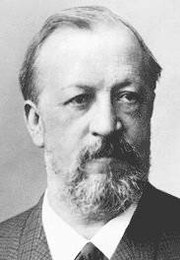Nicolaus Otto

Nikolaus August Otto (June 14, 1832 Holzhausen an der Haide, Nassau - January 26, 1891 Cologne) was the German inventor of the first internal-combustion engine to efficiently burn fuel directly in a piston chamber. Although other internal combustion engines had been invented (e.g. by Étienne Lenoir) these were not based on four separate strokes. The concept of four strokes is likely to have been around at the time of Otto's invention but he was the first to make it practical. [1]
Otto's Life
Nikolaus August Otto was born June, 14 1832. He was born in the small city of Holzhausen, Germany. It was here that he obtained his primary education; but in 1848, when Otto was only sixteen, he left school. He started earning a living by working at a grocery store, and later moved to Cologne. After first seeing Etienne Lenoir’s gas-coal engine design, in 1859, Otto began experimenting with internal combustion engines.
In 1861 Otto had built his first engine based on Lenoir’s design. In 1864, Otto co-founded an engine manufacturing business in Cologne. Along with his business partner Eugen Langen he established “N.A. Otto & Cie.”. This company exists today as “Deutz AG”, who boasts the fact that they are the world's oldest engine manufacturers, with over 140 years of experience. Otto’s company first produced a two stroke engine in 1867. The first major breakthrough at Otto's company was during its founding year, with the development of the "atmospheric gas power machine". This atmospheric engine was later awarded a Gold Medal at the World Exhibition in Paris as an economical drive engine for small businesses. Manufacturing of these engines began in 1868. In 1872 Gottlieb Daimler and Wilhelm Maybach joined his company for a while and together they produced the idea of the four-stroke cycle or, Otto cycle engine, which was first described in 1876. In 1877 Otto received a patent for the “Otto Cycle”, and In 1882, the Philosophical Faculty of the University of Wurzburg awarded Otto with an honorary doctorate[2].
In 1884, Otto once again revolutionized engine design. At this point in time internal combustion engines were stationary due to the fact that they could not run on liquid fuel. They were run with gas, and required a pilot light in order to operate. This changed with the introduction of a low-voltage magneto ignition. This electrical ignition system allows engines to use liquid fuel, making mobile use possible.
Otto’s competitors discredited his Otto Cycle patent in 1886, with a discovery of a pamphlet in which a French engineer named, Alphonse-Eugène Beau de Rochas, had earlier suggested the four stroke engine. This annulled Otto’s patent, but by this time Otto’s engines were the only internal combustion engines widely used. The Otto Cycle engine is the engine that is most widely used today in automobiles, motorcycles and motorboats. Nikolaus August Otto died on January, 26 1891[3]. YEAHHH
Engine development
Daimler and Maybach left Deutz-AG-Gasmotorenfabrik in 1890 and established Daimler Motoren Gesellschaft (Daimler Engines Company) or DMG. Its purpose was the construction of small, high speed engines based on the same technology they helped discover at Otto's firm. In 1885 Daimler and Maybach designed and built a motorcycle with an engine of the Otto Cycle type that they patented. In 1886 they placed a stationary engine into a stagecoach as an experiment and, in 1889, designed and built their first automobile. In 1892 they first sold an automobile to a customer.
In 1900 Daimler died and in 1909 Maybach left Daimler Motoren Gesellschaft. In 1926, their successors at DMG merged with the Karl Benz company, forming Daimler-Benz which is now known as Mercedes-Benz.
Otto Cycle
This engine was designed as a stationary engine and in the action of the engine, the stroke is an upward or downward movement of a piston in a cylinder. Used later in an adapted form as an automobile engine, four up-down strokes are involved: (1) downward intake stroke—coal-gas and air enter the piston chamber, (2) upward compression stroke—the piston compresses the mixture, (3) downward power stroke—ignites the fuel mixture by electric spark, and (4) upward exhaust stroke—releases exhaust gas from the piston chamber. Otto only sold his engine as a stationary motor.
Earlier patents
According to recent historical studies, the Italian inventors Eugenio Barsanti and Felice Matteucci patented a first working efficient version of an internal combustion engine in 1854 in London (pt. Num. 1072). It is claimed that the Otto engine is in many parts at least inspired from this precedent invention [4], but, as yet there is no documentation of knowledge about the Italian engine by Otto.
External links
